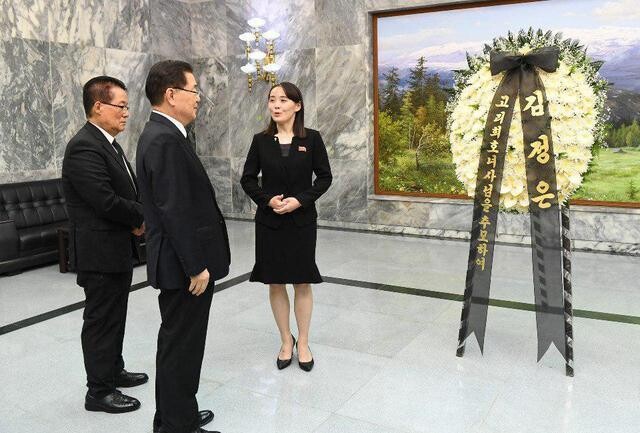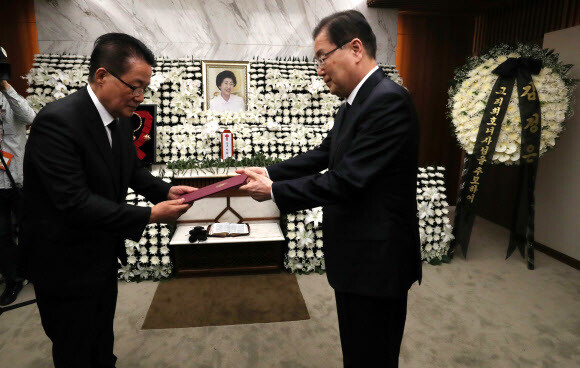hankyoreh
Links to other country sites 다른 나라 사이트 링크
N. Korea sends condolence wreath and message to honor Lee Hee-ho

North Korean leader Kim Jong-un chose to respond to the death of Lee Hee-ho, chair of the Kim Dae-jung Peace Center, by having his sister Kim Yo-jong, first vice director of the Workers’ Party of Korea (WPK), deliver a sympathy floral wreath and a message of condolence. This disappointed some observers, who’d hoped for the kind of high-level sympathy delegation that was sent to South Korea after the death of former South Korean president Kim Dae-jung, Lee’s husband, on Aug. 18, 2009, and the death of Chung Ju-young, founder of the Hyundai Group, on Mar. 21, 2001.
Others are more generous in their assessments, arguing that Kim Jong-un did his best to show respect by selecting Kim Yo-jong, his own flesh and blood and his de facto chief of staff, to personally deliver the wreath and message. While that’s not enough to create a breakthrough in the ongoing deadlock in inter-Korean relations, neither is it the kind of silence or apathy that could have cast a pall on relations. This can be regarded as a compromise that Kim settled on after considerable thought.
The sympathy wreath and message of condolence signed by Kim Jong-un were brought to Tongilgak, a building in the North Korean half of Panmunjom, at 5 pm on June 12 by Kim Yo-jong. The wreath and message were received there by Chung Eui-yong, director of the Blue House National Security Office; Suh Ho, Vice Minister of Unification; and Park Jie-won, lawmaker with the Party for Democracy and Peace (PDP) and head of the committee organizing Lee Hee-ho’s funeral.
Park Jie-won reported that Kim Jong-un’s message of condolence read as follows: “Lee Hee-ho, along with former president Kim Dae-jung, devoted herself to working for the reconciliation and unity of the Korean people and the peace and unification of the nation, in the face of various hardships and adversity. That has laid a precious foundation for the current movement in inter-Korean relations toward independent unification and prosperity, and she will never be forgotten by the Korean people.”
“Having heard the tragic news of the death of Lee Hee-ho, wife of former president Kim Dae-jung, I would like to express my heartfelt condolences and extend consolation to her bereaved family,” Kim Jong-un also wrote in the message.
Kim Yo-jong said that her brother felt particular affection for the deceased and had asked his sister to personally communicate his condolences to leading figures in South Korea, according to Yoon Do-han, the Blue House senior secretary for public communication. Chung Eui-yong also said that Kim Yo-jong had indicated that she hopes South and North Korea will continue cooperating to honor the wishes of Lee Hee-ho, who had dedicated herself to the nation’s harmony and cooperation.
The 15-minute conversation between Chung and Kim Yo-jong, which began at 5 pm, was the first public interaction between high-ranking officials from South and North Korea since talks broke down in the second North Korea-US summit, held in Hanoi this past February.
Answering a question from reporters, Chung said that no letters had been exchanged between Kim Jong-un and South Korean President Moon Jae-in. “Today, both sides were focused on honoring and commemorating the deceased,” Chung said.
But the fact that Yun Geon-yeong, director of the Blue House Governance Situation Room and one of Moon’s closest aides, accompanied Chung raises the possibility that a message from Moon was conveyed to Kim Jong-un.
Yoon Do-han also hinted at that possibility. In response to repeated questions, he said he could only talk about the delivery of the sympathy wreath and message, without explicitly saying that no message had been delivered.
On the North Korean side, Kim Yo-jong was accompanied by Ri Hyon, an official at the WPK United Front Department.
There are likely two reasons why Kim decided against sending a high-ranking sympathy delegation to South Korea to show his condolences, despite South Korean expectations. First, there may have been practical doubts about the effectiveness of sending such a delegation; second, there may have been formal considerations about the status of the deceased.

Delegation wouldn’t have been able to meet President Moon
First, the fact that a high-ranking sympathy delegation, even if it had been sent, wouldn’t have been able to meet South Korean President Moon Jae-in appears to have been one of the key considerations in Kim’s decision to send a message of consolation instead. Lee Hee-ho’s funeral procession is scheduled for the morning of June 14, while South Korean President Moon Jae-in is supposed to return from his tour of three Nordic countries around noon on June 16. Given that indirect dialogue between Moon and Kim was not an option and that North Korea has recently been pushing the South to find a “solution to the fundamental issue,” the North likely didn’t feel the need to send a sympathy delegation that would be expected to engage in high-level dialogue.
Second, North Korea appears to have considered protocol related to previous times that South and North Korea have expressed condolences, either through messages or visits. When former North Korean leader Kim Jong-il passed away in December 2011, Lee visited the Kumsusan Memorial Palace (today called the Kumsusan Palace of the Sun) to personally convey her condolences to Kim Jong-un, but Kim nevertheless opted to send sympathy flowers and a message of condolence in place of sending a sympathy delegation. A useful parallel can be found in how North Korea responded to the death of Park Yong-gil, an activist for women’s rights and unification and the wife of pastor and democracy activist Moon Ik-hwan, on Sept. 25, 2011 — by sending a sympathy telegram signed by Kim Jong-il.
The apparent commonality in North Korea’s method of expressing condolences for the members of these two couples (Moon Ik-hwan and Park Yong-gil, and Kim Dae-jung and Lee Hee-ho) is that it distinguishes between those who engaged in dialogue with North Korea’s supreme leader and those who have not. While Moon Ik-hwan sat down with Kim Il-sung twice for talks in Pyongyang in March 1989, Park never did, despite visiting the North several times — and neither did Lee Hee-ho. The North essentially primarily treated Lee as being the spouse of Kim Dae-jung, just as it had treated Park as the spouse of Moon Ik-hwan.
By Lee Je-hun, senior staff writer, and Noh Ji-won, staff reporter
Please direct comments or questions to [english@hani.co.kr]

Editorial・opinion
![[Column] Has Korea, too, crossed the Rubicon on China? [Column] Has Korea, too, crossed the Rubicon on China?](https://flexible.img.hani.co.kr/flexible/normal/500/300/imgdb/original/2024/0419/9317135153409185.jpg) [Column] Has Korea, too, crossed the Rubicon on China?
[Column] Has Korea, too, crossed the Rubicon on China?![[Correspondent’s column] In Japan’s alliance with US, echoes of its past alliances with UK [Correspondent’s column] In Japan’s alliance with US, echoes of its past alliances with UK](https://flexible.img.hani.co.kr/flexible/normal/500/300/imgdb/original/2024/0419/2317135166563519.jpg) [Correspondent’s column] In Japan’s alliance with US, echoes of its past alliances with UK
[Correspondent’s column] In Japan’s alliance with US, echoes of its past alliances with UK- [Editorial] Does Yoon think the Korean public is wrong?
- [Editorial] As it bolsters its alliance with US, Japan must be accountable for past
- [Guest essay] Amending the Constitution is Yoon’s key to leaving office in public’s good graces
- [Editorial] 10 years on, lessons of Sewol tragedy must never be forgotten
- [Column] A death blow to Korea’s prosecutor politics
- [Correspondent’s column] The US and the end of Japanese pacifism
- [Guest essay] How Korea turned its trainee doctors into monsters
- [Guest essay] As someone who helped forge Seoul-Moscow ties, their status today troubles me
Most viewed articles
- 1[Column] The clock is ticking for Korea’s first lady
- 2Hong Se-hwa, voice for tolerance whose memoir of exile touched a chord, dies at 76
- 3After 2 months of delayed, denied medical care, Koreans worry worst may be yet to come
- 4[Column] Has Korea, too, crossed the Rubicon on China?
- 5US overtakes China as Korea’s top export market, prompting trade sanction jitters
- 6Samsung barricades office as unionized workers strike for better conditions
- 7[Correspondent’s column] In Japan’s alliance with US, echoes of its past alliances with UK
- 8All eyes on Xiaomi after it pulls off EV that Apple couldn’t
- 9[Correspondent’s column] The US and the end of Japanese pacifism
- 10[Guest essay] How Korea turned its trainee doctors into monsters